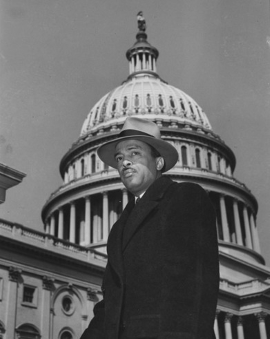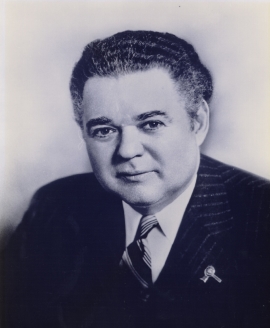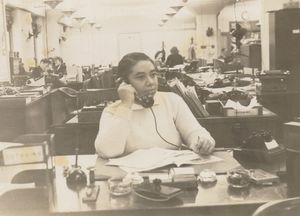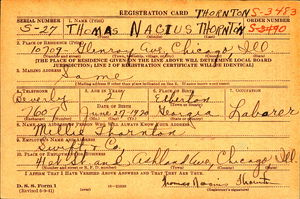African American men and women have worked on Capitol Hill since Congress moved to the new capital in the District of Columbia in 1800. Black laborers, enslaved and free, helped to build the Capitol. In the 19th century, African Americans worked as messengers, groundskeepers, pages, carpenters, and cafeteria workers. In the 20th century, as they began to move into professional positions, they challenged the discriminatory practices that prevailed in their workplaces. Years before the Civil Rights Act of 1964 legally ended segregation, four courageous individuals demanded the integration of Senate spaces.

In January 1946, Louis Lautier, a correspondent for the Atlanta Daily World and the Negro Newspaper Publishers Association, applied to the Senate Standing Committee of Correspondents for admission to the daily press gallery. In 1884 the Senate had made the Standing Committee, a group of elected members of the press gallery, responsible for credentialing congressional correspondents. Under Senate rules, the daily press gallery was open to correspondents “who represent daily newspapers or newspaper associations requiring telegraphic service.” Most African American papers were published weekly. A separate periodicals gallery served reporters of weekly magazines, not newspapers. Rules that seemingly were intended to prevent lobbyists from moonlighting as correspondents effectively made the Senate’s daily press gallery and the periodicals gallery off-limits to Black reporters. As Senate Historian Emeritus Donald Ritchie explains, “There [was] never a rule of the press gallery that says, ‘You have to be a white man,’ but the rules are written in such a way that that’s the only people who could get in.1
African American reporters had applied for admission on occasion despite these regulations, but their applications had all met the same fate—rejection. When rejecting Lautier’s application for admission in January 1946, the Standing Committee explained, “Inasmuch as your chief attention and your principal earned income is not obtained from daily telegraphic correspondence for a daily newspaper, as required under [Senate rules], you [are] not eligible.” Lautier then revised his application, noting that he was “jointly employed” by the Atlanta Daily World and the Negro Newspaper Publishers Association, “with each organization paying half of my salary.” The Standing Committee stood by its initial decision, so Lautier appealed directly to the Senate Committee on Rules and Administration, which had jurisdiction over the press galleries. The Rules Committee chairman, Democrat Harry Byrd of Virginia, did not intervene. Undeterred, Lautier resubmitted his application to the Standing Committee in November 1946.2
When the 80th Congress convened for its first session in January 1947, Republicans gained control of the Senate for the first time since 1933. One of the first orders of business facing the Senate was the seating of Senator Theodore Bilbo, a vocal white supremacist. In 1946 a Senate committee had investigated allegations by Black Mississippians that Bilbo had “conducted an aggressive and ruthless campaign” to deny Blacks the right to vote in the 1946 Democratic primary. A second, separate Senate inquiry had concluded that Bilbo had accepted “gifts, services, and political contributions” from war contractors whom he had assisted in securing government defense contracts. Lautier intended to cover the Senate debate, but without admittance to the press galleries, he was forced to wait in long lines for a seat in the public galleries, where Senate rules prohibited him from taking notes.3

Weeks later, on March 4, “after exhaustive deliberations and a personal hearing,” the Standing Committee again rejected Lautier’s application. Editorials in the national press urged the Standing Committee to reconsider its decision, and Lautier appealed to the new Rules Committee chairman, Senator C. Wayland “Curley” Brooks of Illinois. “Since the Standing Committee of Correspondents has acted arbitrarily in refusing me admission to the press galleries, and since under the interpretation of the rules Negro correspondents are barred solely because of their race or color, it appears that the Senate Rules Committee has the responsibility and duty to see that this gross discrimination against the Negro press is removed,” Lautier wrote.4
Senator Brooks, who had recently encountered separate allegations of racial discrimination in Senate facilities, readily agreed to investigate Lautier’s case. On March 18, 1947, Chairman Brooks convened a hearing to consider both Lautier’s application and the issue of discrimination in Senate dining facilities. “In the Capitol of the greatest free country in the world, we certainly should have no discrimination,” Brooks declared.5
The hearings first addressed Lautier’s application. Lautier testified that he met the qualifications for admittance to the daily press gallery under the existing rules. “I believe that I comply with the rules, if reasonably interpreted … because daily I gather news for the Atlanta Daily World.” While the rules had not been designed to “exclude Negro correspondents” from the press galleries “solely because of their race or color … that is the practical effect of the interpretation given the rules by the Standing Committee of Correspondents,” Lautier explained to committee members. Lautier described how the Atlanta Daily World and the Negro Newspaper Publishers Association rendered a vital service to African Americans by focusing on issues of particular significance to them. At a recent hearing to consider amending the cloture rule, for example, Louisiana senator John Overton had stated that “the Democratic South stands for white supremacy.” Overton’s statement, as well as debates about proposed changes to Senate rules and procedures, had been “inadequately reported by the white daily press,” Lautier explained. His readers relied upon Black correspondents to be “intelligently informed of what is going on in the Congress.”6

Testifying in defense of the decision to deny Lautier’s admission, the chairman of the Standing Committee, Griffing Bancroft of the Chicago Sun, maintained that race had not played a role in its decision making and recommended a rules revision “so that facilities could be provided for the weekly papers.” Brooks pressed Bancroft; couldn’t the situation be immediately resolved by admitting Lautier? That is not a long-term solution, Bancroft replied, because without revising the rules for admission, African American correspondents writing for weekly papers would continue to be denied admission to the daily press gallery and the periodicals gallery. Lautier belived that a rules change would not be required in his case, because “under a reasonable interpretation of [the current] rules I am entitled to admission.” Members of the Rules Committee agreed with Lautier and voted unanimously to approve his application for admission to the Senate daily press gallery. It was only a partial victory for Black correspondents, however, as it was not clear if Lautier’s admission had paved the way for other Black reporters.7
At the same time that Lautier was appealing the decision of the Standing Committee for credentials to the daily press gallery, Alice Dunnigan, the new Washington correspondent for the Associated Negro Press, had just arrived in the city to cover the Bilbo floor debate. Unaware of the Lautier case, Dunnigan submitted applications to the Standing Committee for admission to the daily press gallery and to the periodicals gallery, but she waited weeks with no answer. She called repeatedly to inquire about her application and made personal visits to the Capitol, “probably making a nuisance of [herself].” Even after Chairman Brooks’s hearing on Lautier’s application, Dunnigan still did not get an answer. After some investigation, Dunnigan learned that she faced another kind of discrimination. The founder and director of her news organization, Claude Barnett, had failed to provide a letter of recommendation in support of Dunnigan’s application, as required by the Standing Committee. When Dunnigan confronted Barnett about the issue, he explained, “For years, we have been trying to get a [Black] man accredited to the Capitol Galleries and have not succeeded. What makes you think that you—a woman—can accomplish this feat?” Dunnigan persisted, however, and Barnett eventually sent his letter to the Standing Committee, who promptly approved her application for admission to the daily gallery in June 1947. “My acceptance received widespread publicity,” Dunnigan later recalled, “and the Republican-controlled Congress received credit for opening the Capitol Press Galleries” to African American reporters.8

Chairman Brooks’s hearing on the Senate press galleries had a positive impact on integrating those Senate spaces, but the fight to integrate the Senate’s dining facilities took a bit longer. Brooks had appointed World War II army veteran Thomas N. Thornton, Jr., an African American, to a position as a mail carrier in the Senate post office on February 20, 1947. One day in early March, Thornton stopped at the luncheonette in the Senate Office Building (now the Russell Senate Office Building) and ordered a sandwich and coffee. A waitress asked Thornton to take his order to go, but he refused, sat down at a table, and ate his meal. Though Senate rules prohibited discrimination in Senate facilities, Thornton had violated a long-standing Senate practice of “whites only” dining facilities. Word of Thornton’s actions spread, and Washington Post syndicated columnist Drew Pearson reported that Sergeant at Arms Edward McGinnis had reprimanded Thornton and advised him not to eat again inside Senate dining facilities. During the March 1947 Rules Committee hearings about discrimination in Senate facilities, the Architect of the Capitol, David Lynn, whose responsibilities included the operation of Senate restaurants, assured Chairman Brooks that discrimination in Senate dining facilities would not be tolerated. “When this incident happened, it was purely a misunderstanding on the part of a new [restaurant] employee or it would never have happened,” reported the director of Senate dining facilities, D. W. Darling.9

Despite these assurances, de facto segregation in the Capitol’s dining rooms persisted for years. Not long after joining Senator Stuart Symington’s personal staff in 1953, Christine McCreary attempted to eat in the Senate cafeteria. When an anxious hostess reminded her that the cafeteria served “only … people who work in the Senate,” McCreary explained, patiently, that she worked for Senator Symington. The hostess demurred, then reluctantly invited McCreary to “take a seat anyplace you can find.” Diners gawked as McCreary passed through the serving line with tray in hand. “You could hear a pin drop,” she later recalled. Silently enduring the “snide remarks” of those who disapproved of her effort, McCreary remembered her first years of Senate service as “a lonesome time.” But she refused to give up. “I went back [to the cafeteria] the next day, and the next day, until finally they got used to seeing me coming.”10
As we commemorate Black History Month, let us acknowledge the perseverance and determination of members of the Senate community, including Lautier, Dunnigan, Thornton, and McCreary, and their remarkable courage in challenging the Senate’s long-standing discriminatory practices.
Notes
3. Special Committee to Investigate Senatorial Campaign Expenditures, Investigation of Senatorial Campaign Expenditures, 1946, S. Rep. 80-1, 80th Cong., 1st sess., January 3, 1947; Special Committee to Investigate the National Defense Program, Investigation of the National Defense Program, Additional Report, Transactions Between Senator Theodore G. Bilbo and Various War Contractors, S. Rep. 79-110, Part 8, January 2, 1947, 79th Cong., 2nd sess., 2; Donald A. Ritchie, Reporting from Washington: The History of the Washington Press Corps (New York: Oxford University Press, 2005), 35.
6. Hearing on the Application of Louis R. Lautier for Admission to Senate Press Gallery, 4, 10; Senate Committee on Rules and Administration, Amending Senate Rule Relating to Cloture: Hearings before a Subcommittee of the Committee on Rules and Administration on S. Res. 25, 30, 32, and 39, 80th Cong., 1st sess., January 28, February 4, 11, 18, 1947.
8. Alice Dunnigan, Alone Atop the Hill: The Autobiography of Alice Dunnigan, Pioneer of the National Black Press (Athens: The University Press of Georgia, 2015) 107–9, 110–12; Ritchie, Reporting From Washington, 39–40; “Credentials,” January 1947, Alice Dunnigan Case, included in the subject files of the Senate Historical Office: Senate Press Gallery, Standing Committee on Correspondents.
9. Kenneth O’Reilly, “The Jim Crow Policies of Woodrow Wilson,” Journal of Blacks in Higher Education, 17 (Autumn, 1997), 117–21; Rodney Dutcher, “Behind the Scenes in Washington,” Times-News, Hendersonville, N.C., March 3, 1934; Drew Pearson, “Color Bar in Senate Restaurant,” Washington Post, 8 Mar 1947, 9; Hearing on the Application of Louis R. Lautier for Admission to Senate Press Gallery, 61–64, 66; Report of the Secretary of the Senate, July 1, 1946, to January 3, 1947 and January 4, 1947, to June 30, 1947, S. Doc. 80-117, 80th Cong., 2nd sess., January 7, 1948, 260.